

| 2013 | Master Index | 1600's |
Chronology of Aviation History Before the 17th Century
The Dawn of Flight
Dawn of Flight Events
c.1700 BCE (Crete) — Young Icarus abandons all caution and plunges to his death - During a daring escape flight to freedom, Athenian engineer Daedalus and his son Icarus set out on a VFR
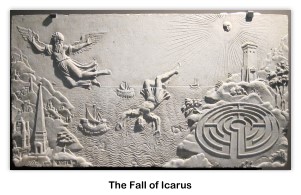 flight from Crete to Naples. The two escapees had fabricated themselves wings out of wax and feathers. During their flight, Icarus ignored his father's warnings not to fly too
high. Young Icarus abandoning all caution, flew higher towards the sun. The increased heating effects of the sun lead to a structural failure of the wax binding the feathers to his artificial wings. The resulting loss in lift caused Icarus to fall into the sea and perish. Daedalus continued his flight on to Naples and landed safely. After clearing customs, Daedalus swore never to fly again. He was heard to say: "The sky, like the sea, is the abode of the Gods and a dangerous place for mortals." NTSB officials have yet to comment on the case. [1,3]
flight from Crete to Naples. The two escapees had fabricated themselves wings out of wax and feathers. During their flight, Icarus ignored his father's warnings not to fly too
high. Young Icarus abandoning all caution, flew higher towards the sun. The increased heating effects of the sun lead to a structural failure of the wax binding the feathers to his artificial wings. The resulting loss in lift caused Icarus to fall into the sea and perish. Daedalus continued his flight on to Naples and landed safely. After clearing customs, Daedalus swore never to fly again. He was heard to say: "The sky, like the sea, is the abode of the Gods and a dangerous place for mortals." NTSB officials have yet to comment on the case. [1,3]c.1000 BCE (India) — Mythical flying machines called “Vimanas” are mentioned in the Vedas. The search for clues to humanity's creation is often linked to ancient astronauts who came here in the beginning in Flying Vehicles, leaving behind clues to their encounters with humans. Pictographs and megalithic monuments throughout the planet describe human interaction with ancient astronauts, allowing those in our time-line to piece together what happened in the past that shape out destiny today. Descriptions in the Vedas and later Indian literature detail “vimanas” of various shapes and sizes. A “vimana” is a mythological flying machine, described in the ancient mythology of India. References to these flying machines are commonplace in ancient Indian texts, even describing their use in warfare. As well as being able to fly within Earth's atmosphere, vimanas were also said to be able to travel into space and travel submerged underwater. [4]
c.850 BCE (New Troy) — Kings are brought low by failed attempts to conquer the air - The legendary King Bladud (the father of Shakespeare's King Lear) it is said to have been another
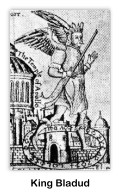 victim of an early attempt to fly when his experiment went tragically wrong. A great crowd of citizens had gathered at New Troy (London) to see their ruler's brave attempt to fly over the city, but they could only watch in horror as the king lost his balance in mid-flight and tumbled to his death. Bladud had attached wings to his arms and managed to take off when he was lifted up by a gust of wind. But as he tried to move through the air by flapping his arms, he lost his balance and crashed into the temple of Apollo, suffering horrible injuries from which he died. Known as a wizard, Bladud spread his love of magic throughout the kingdom during his reign, says the story. But pride got the better of him when he made this attempt to fly. A similar story of a King humiliated by failure in the air comes from Persia. King Kai Kawus, who was the ruler of Persia in 1500 BC, is said to have tied pieces of meat on two long poles attached to his throne. He then yoked four starving eagles to the throne. As they flapped in vain to reach the food, they took him up in the air and flew him all the way to China, where exhaustion overtook them. The journey ended ignominiously in a forest, and Kai Kawus renounced flying forever. These legendary failures by great and powerful men bear the same message … man was never meant to fly. [1,5]
victim of an early attempt to fly when his experiment went tragically wrong. A great crowd of citizens had gathered at New Troy (London) to see their ruler's brave attempt to fly over the city, but they could only watch in horror as the king lost his balance in mid-flight and tumbled to his death. Bladud had attached wings to his arms and managed to take off when he was lifted up by a gust of wind. But as he tried to move through the air by flapping his arms, he lost his balance and crashed into the temple of Apollo, suffering horrible injuries from which he died. Known as a wizard, Bladud spread his love of magic throughout the kingdom during his reign, says the story. But pride got the better of him when he made this attempt to fly. A similar story of a King humiliated by failure in the air comes from Persia. King Kai Kawus, who was the ruler of Persia in 1500 BC, is said to have tied pieces of meat on two long poles attached to his throne. He then yoked four starving eagles to the throne. As they flapped in vain to reach the food, they took him up in the air and flew him all the way to China, where exhaustion overtook them. The journey ended ignominiously in a forest, and Kai Kawus renounced flying forever. These legendary failures by great and powerful men bear the same message … man was never meant to fly. [1,5]c.500 BCE (China) — The Chinese start to use kites. [6]
c.400 BCE (Greece) — Archytas, the Greek philosopher, mathematician, astronomer, statesman and strategist, designed and built a bird-shaped, apparently steam powered model named “The Pigeon” (Greek: Peristera), which is said to have flown some 200 meters. According to Aulus Gellius, the mechanical bird was suspended on a string or pivot and was powered by a “concealed aura or spirit.” [2]
c.200 BCE (China) — The Chinese invented the first hot air balloon, the “Kongming” lantern. Sky lanterns, also known as “Kongming Lantern” are airborne paper lanterns
 traditionally found in some Asian cultures. They are constructed from oiled rice paper on a bamboo frame, and contain a small candle or fuel cell composed of a waxy flammable material. When lit, the flame heats the air inside the lantern, thus lowering its density causing the lantern to rise into the air. The sky lantern is only airborne for as long as the flame stays alight, after which the lantern floats back to the ground. Sky lanterns are also referred to as sky candles or fire balloons, however the latter term is also used to refer to balloon munitions used during World War II. According to popular lore, the Kongming Lantern was the first hot air balloon, said to be invented by the Chinese sage and military strategist Zhuge Liang, whose reverent term of address was Kongming. They were first deployed at the turn of the 3rd century as a type of signaling balloon or, it is claimed, as a type of spy blimp in warfare. Alternatively the name may come from the lantern's resemblance to the hat Kongming is traditionally shown to be wearing. [7]
traditionally found in some Asian cultures. They are constructed from oiled rice paper on a bamboo frame, and contain a small candle or fuel cell composed of a waxy flammable material. When lit, the flame heats the air inside the lantern, thus lowering its density causing the lantern to rise into the air. The sky lantern is only airborne for as long as the flame stays alight, after which the lantern floats back to the ground. Sky lanterns are also referred to as sky candles or fire balloons, however the latter term is also used to refer to balloon munitions used during World War II. According to popular lore, the Kongming Lantern was the first hot air balloon, said to be invented by the Chinese sage and military strategist Zhuge Liang, whose reverent term of address was Kongming. They were first deployed at the turn of the 3rd century as a type of signaling balloon or, it is claimed, as a type of spy blimp in warfare. Alternatively the name may come from the lantern's resemblance to the hat Kongming is traditionally shown to be wearing. [7]c.220 BCE (China) — The Chinese use kites as range finders. [6]
c.559 CE (China) — Yuan Huangtou, Ye, first manned kite glide to take off from a tower. Yuan Huangtou was the son of emperor Yuan Lang of Eastern Wei. At that time, Gao Yang took control the court of Eastern Wei and set the emperor as puppet. Finally, Yuan Huangtou was imprisoned by Gao Yang and, against his will, flown via a large kite from the tower of Ye, China. He survived this flight, but was later executed. [8]
c.852 CE (Córdoba, Spain) — Abbas Ibn Firnas jumps from a tower in wearing an oversized cloak, which acts as a parachute to break his fall. Abbas Ibn Firnas (810-887 A.D.), also known as Abbas Qasim Ibn Firnas, was a Muslim Andalusian polymath: an inventor, engineer, aviator, physician, Arabic poet, and Andalusian musician. Of Berber descent, he was born in Izn-Rand Onda, Al-Andalus (today's Ronda, Spain), and lived in the Emirate of Córdoba. He is known for an early attempt at aviation. Ibn Firnas designed a water clock called Al-Maqata, devised a means of manufacturing colorless glass, he invented various glass planispheres, made corrective lenses "reading stones", developed a chain of rings that could be used to simulate the motions of the planets and stars, and developed a process for cutting rock crystal that allowed Spain to cease exporting quartz to Egypt to be cut. In his house he built a room in which spectators witnessed stars, clouds, thunder, and lightning, which were produced by mechanisms located in his basement laboratory. He also devised “some sort of metronome.” He is also said to have made an attempt at flight using a set of wings. The only evidence for this is an account by the Moroccan historian Ahmed Mohammed al-Maqqari (d. 1632), composed seven centuries later: “Among other very curious experiments which he made, one is his trying to fly. He covered himself with feathers for the purpose, attached a couple of wings to his body, and, getting on an eminence, flung himself down into the air, when according to the testimony of several trustworthy writers who witnessed the performance, he flew a considerable distance, as if he had been a bird, but, in alighting again on the place whence he had started, his back was very much hurt, for not knowing that birds when they alight come down upon their tails, he forgot to provide himself with one.” Al-Maqqari is said to have used in his history works “many early sources no longer extant,” but in case of Firnas the only one cited by him was a 9th century poem written by Mu'min ibn Said, a court poet of Córdoba under Muhammad I (d. 886), who was acquainted with and usually critical of Ibn Firnas. The pertinent verse runs: “He flew faster than the Phoenix in his flight when he dressed his body in the feathers of a vulture.” No other surviving sources refer to the event. [9]
c.875 CE (Córdoba, Spain) — At an age of 65 years, Abbas Ibn Firnas became the first man in history to make a scientific attempt at flying. He built his own glider, and launched himself from a mountain. The flight was largely successful, and was widely observed by a crowd that he had invited. Although he injured his back landing, his flight time was estimated to run for over ten minutes. [6]
c.1000 CE (Pacific Ocean) — The glider kite is presumed to have gained currency around the Pacific. It was probably manned and used for military, religious and ceremonial reasons. [6]
c.1010 (Wiltshire, England) — Monk is crippled in brave gliding - The monk Eilmer, also known as Oliver of Malmesbury, has broken his legs in a flying accident and is now crippled. In
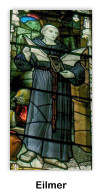 spite of his extensive injuries, he remains resolute in his belief that people can fly, and blames his misfortune on not having added a tale to his apparatus. The flying monks wings were attached to his hands and feet to keep them rigid and his body horizontal during the descent. He chose to jump from the tall tower of Malmesbury Abbey, which would have sufficient up-currents to support him or so he thought. While he is reported to have managed an uncontrolled glide of about 200 yards, he was unable to prevent himself from coming to earth with a most terrific bump. [1,6,10]
spite of his extensive injuries, he remains resolute in his belief that people can fly, and blames his misfortune on not having added a tale to his apparatus. The flying monks wings were attached to his hands and feet to keep them rigid and his body horizontal during the descent. He chose to jump from the tall tower of Malmesbury Abbey, which would have sufficient up-currents to support him or so he thought. While he is reported to have managed an uncontrolled glide of about 200 yards, he was unable to prevent himself from coming to earth with a most terrific bump. [1,6,10]1241 CE (Legnickie Pole, present day Poland) — The Mongolian army uses lighted kites in the Battle of Legnica. The Battle of Legnica, also known as the Battle of Liegnitz or Battle of Wahlstatt, was a battle between the Mongol Empire and the combined defending forces of European fighters that took place at Legnickie Pole (Wahlstatt) near the city of Legnica in Silesia on 9 April 1241. A combined force of Poles, Czechs and Germans under the command of the Polish Duke Henry II the Pious of Silesia, supported by feudal nobility and a few knights from military orders sent by the Pope, attempted to halt the Mongol invasion of Europe. The battle came two days before the Mongol victory over the Hungarians at the much larger Battle of Mohi. [6,11]
c.1260 CE (England) — Bacon says people could learn to fly - Roger Bacon, 37, Franciscan monk and scientist, puts forward two methods of human flight in his book De Mirabili Potestate
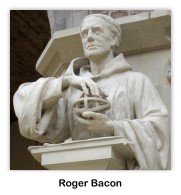 Artis et Naturae. One suggestion is "an engine for flying" with "a man sitting in the midst thereof." This would fly "by turning only about an instrument, which moves artificial wings made to beat the air, much after the fashion of a bird's flight." Bacon proposes that "a large hollow globe … filled with ethereal air … would float on the atmosphere as a ship on water." Bacon as shown by his experiments that the atmosphere is an invisible fluid in which less dense objects could well float. [1,6,12]
Artis et Naturae. One suggestion is "an engine for flying" with "a man sitting in the midst thereof." This would fly "by turning only about an instrument, which moves artificial wings made to beat the air, much after the fashion of a bird's flight." Bacon proposes that "a large hollow globe … filled with ethereal air … would float on the atmosphere as a ship on water." Bacon as shown by his experiments that the atmosphere is an invisible fluid in which less dense objects could well float. [1,6,12]1300 CE (Venezia) — Marco Polo tells of man-carrying kites - Famous Venetian merchant Marco Polo, upon recent return from his business travels throughout China, has brought back some
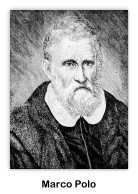 strange tales. If his tales are true, humans can float above the surface of the earth! According to polls reports, Chinese businessmen are reluctant to board merchant ships until it has been ascertained whether or not the journey will be prosperous. To do this, a drunkard or a full is seized by the ship's crew and tied to a huge kite made of cloth and will, attached by eight ropes to the main tethering rope, held by the crew. When set to opposite of the wind, the kite rises into the sky, often with the frightened passenger screening for pity. The kite liens, the men on the ground pull a rope. This sets it up right once more, and by letting out more rope it rises higher. Once it is seen to fly well, the businessmen rush to the ship is on board. The kite does not fly well emerge as believe they must look for another ship, and the vessel remains import that year. [1,6,13]
strange tales. If his tales are true, humans can float above the surface of the earth! According to polls reports, Chinese businessmen are reluctant to board merchant ships until it has been ascertained whether or not the journey will be prosperous. To do this, a drunkard or a full is seized by the ship's crew and tied to a huge kite made of cloth and will, attached by eight ropes to the main tethering rope, held by the crew. When set to opposite of the wind, the kite rises into the sky, often with the frightened passenger screening for pity. The kite liens, the men on the ground pull a rope. This sets it up right once more, and by letting out more rope it rises higher. Once it is seen to fly well, the businessmen rush to the ship is on board. The kite does not fly well emerge as believe they must look for another ship, and the vessel remains import that year. [1,6,13]1486-1513 CE (Florence, Italy) — Italian artist Leonardo da Vinci designs ingenious experimental flying machines - Leonardo da Vinci, greatest scientist and artist of the age, has
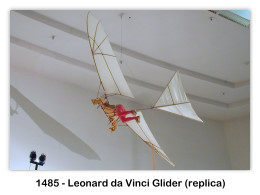
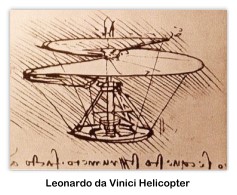 devoted a large portion of his time to the problem of how people might invent a way of flying. He is reputed to have produced 500 sketches and 35,000 words on the subject of aeronautical devices. Leonardo has considered hundreds of ideas for human flight and has sketched many of them, but he appears to have made and tested only one, a simple a helicopter, with the wing of spiral shape. If a light source of power had existed to propel it, this arrangement might well be made to work. From the outset he has grasped that, unlike birds, human beings are simply not built to fly. They are too heavy and not strong enough and will never be able to fly using arms or legs alone. Accordingly, Leonardo has proposed an "ornithopter," in which two rocking beams with large flaps or paddles are driven by the wearer's arms and legs working in unison. He has also realized that a flying machine must be controlled. He is added to this particular device a cruciform tail, which wires connect to the aviator's head. Movements in the head to the left or right swing the tail, as if it were a rudder, while an up or down motion controls the horizontal tail or elevator. Leonardo has also sketched a more advanced flying machine in which the aviator lies down on a light wooden plank and works two large wings by means of hand levers and foot pedals, the latter driving the wings via cords and pulleys. In this machine Leonardo hopes to reproduce his observations on the bird's ability to camber or curve the cross-section of their wings. Another invention from the great Florentine is a parachute, which would enable humans to descend safely from heights. But sadly, while many of his ideas appear to be basically practical, the skills and materials which would enable them to be carried out do not exist. His legacy is likely to be merely a vast gallery of sketches, products of a brilliant, fertile mind. [1,14,15]
devoted a large portion of his time to the problem of how people might invent a way of flying. He is reputed to have produced 500 sketches and 35,000 words on the subject of aeronautical devices. Leonardo has considered hundreds of ideas for human flight and has sketched many of them, but he appears to have made and tested only one, a simple a helicopter, with the wing of spiral shape. If a light source of power had existed to propel it, this arrangement might well be made to work. From the outset he has grasped that, unlike birds, human beings are simply not built to fly. They are too heavy and not strong enough and will never be able to fly using arms or legs alone. Accordingly, Leonardo has proposed an "ornithopter," in which two rocking beams with large flaps or paddles are driven by the wearer's arms and legs working in unison. He has also realized that a flying machine must be controlled. He is added to this particular device a cruciform tail, which wires connect to the aviator's head. Movements in the head to the left or right swing the tail, as if it were a rudder, while an up or down motion controls the horizontal tail or elevator. Leonardo has also sketched a more advanced flying machine in which the aviator lies down on a light wooden plank and works two large wings by means of hand levers and foot pedals, the latter driving the wings via cords and pulleys. In this machine Leonardo hopes to reproduce his observations on the bird's ability to camber or curve the cross-section of their wings. Another invention from the great Florentine is a parachute, which would enable humans to descend safely from heights. But sadly, while many of his ideas appear to be basically practical, the skills and materials which would enable them to be carried out do not exist. His legacy is likely to be merely a vast gallery of sketches, products of a brilliant, fertile mind. [1,14,15]1496 CE (Italy) — The Italian mathematician Giambattista Danti is supposed to have flown from a tower. [2]
c.1500 CE (Netherlands) — Hieronymus Bosch shows in his triptych The Temptation of the Holy Antonius, among other things, two fighting airships above a burning town. Bosch was a Dutch painter. His work is known for its use of fantastic imagery to illustrate moral and religious concepts and narratives. [6]
1507 (Stirling, Scotland) — Italian-born John Damian launches himself from the walls of Stirling Castle, but falls to the ground, breaking several bones. He blamed his failure on the fact that he used feathers from a chicken, a bird which does not fly, when he made his wings. [1,6]
1558 (Naples, Italy) — Giambattista della Porta publishes a theory and a construction manual for a kite. Also known as Giovanni Battista Della Porta and John Baptist Porta, he was an Italian scholar, polymath and playwright who lived in Naples at the time of the Scientific Revolution and Reformation. Giambattista della Porta spent the majority of his life on scientific endeavors. He benefited from an informal education of tutors and visits from renowned scholars. His most famous work, first published in 1558, was entitled Magiae Naturalis (Natural Magic). In this book he covered a variety of the subjects he had investigated, including the study of: occult philosophy, astrology, alchemy, mathematics, meteorology, and natural philosophy. He was also referred to as “professor of secrets.” [6]
Works Cited
- Gunston, Bill, et al. Chronicle of Aviation. Liberty, Missouri: JL Publishing Inc., 1992.
- Wikipedia, Aviation History/Mythology
- Wikipedia, Icarus
- Wikipedia, Vimana
- Wikipedia, King Bladud
- Wikipedia, Timeline of Aviation Before the 18th Century
- Wikipedia, Sky Lanterns
- Wikipedia, Yuan Huangtou
- Wikipedia, Abbas Ibn Firnas
- Wikipedia, Eilmer of Malmesbury
- Wikipedia, Battle of Legnica
- Wikipedia, Roger Bacon
- Wikipedia, Marco Polo
- Shupek, John (photos), The Skytamer Archive. Skytamer Images, Whittier, CA
- Wikipedia, Leonardo da Vinci
Copyright © 2013 Skytamer Images, Whittier, California
All rights reserved